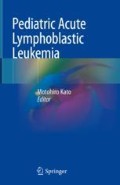Abstract
Flow cytometric immunophenotyping still stands on a significant position as a diagnostic tool against acute lymphoblastic leukemia (ALL). Improvement of flow cytometry (FCM) instrument and increasing availability of monoclonal antibodies and fluorochromes enable multicolor analysis and accurate diagnosis. But molecular diagnostic method also made a big progress especially in genome-wide analysis. The World Health Organization (WHO) classification of tumors of the hematopoietic and lymphoid tissues was first established in 2008, then in 2017 it was revised diagnostic criteria including morphologic, phenotypic, and more genotypic features (Wenzinger et al., Curr Hematol Malig Rep 13:275–288, 2018). Thus, such a recent progress of genomic analysis alters a role of immunophenotyping for pediatric ALL. Currently, entities of pediatric ALL are divided into subtypes by not only immunophenotyping but various cytogenetic abnormalities. Immunophenotyping may become no longer crucial but only exist to decide initial treatment until an identification of cytogenetic abnormalities in the near future. However, recently it turned out that immunophenotypic patterns indicate a specific feature according to each cytogenetic abnormality. To predict cytogenetic abnormality based on specific immunophenotype may fulfill an efficient cytogenetic diagnosis for most of known cytogenetic abnormalities. This chapter indicates the present situation of flow cytometric testing and current application for pediatric ALL, based on a new era of genomic analysis.
Access this chapter
Tax calculation will be finalised at checkout
Purchases are for personal use only
References
Wenzinger C, Williams E, Gru AA. Updates in the pathology of precursor lymphoid neoplasms in the revised fourth edition of the WHO classification of Tumors of hematopoietic and lymphoid tissues. Curr Hematol Malig Rep. 2018;13(4):275–88.
Horibe K, et al. Incidence and survival rates of hematological malignancies in Japanese children and adolescents (2006–2010): based on registry data from the Japanese Society of Pediatric Hematology. Int J Hematol. 2013;98(1):74–88.
Iwamoto S, et al. Flow cytometric analysis of de novo acute lymphoblastic leukemia in childhood: report from the Japanese Pediatric Leukemia/lymphoma study group. Int J Hematol. 2011;94(2):185–92.
Sotillo E, et al. Convergence of acquired mutations and alternative splicing of CD19 enables resistance to CART-19 immunotherapy. Cancer Discov. 2015;5(12):1282–95.
Chiaretti S, Zini G, Bassan R. Diagnosis and subclassification of acute lymphoblastic leukemia. Mediterr J Hematol Infect Dis. 2014;6(1):e2014073.
Koehler M, et al. Transitional pre-B-cell acute lymphoblastic leukemia of childhood is associated with favorable prognostic clinical features and an excellent outcome: a Pediatric oncology group study. Leukemia. 1993;7(12):2064–8.
Tsuganezawa K, et al. Flow cytometric diagnosis of the cell lineage and developmental stage of acute lymphoblastic leukemia by novel monoclonal antibodies specific to human pre-B-cell receptor. Blood. 1998;92(11):4317–24.
Tsao L, et al. Mature B-cell acute lymphoblastic leukemia with t(9;11) translocation: a distinct subset of B-cell acute lymphoblastic leukemia. Mod Pathol. 2004;17(7):832–9.
Kelemen K, et al. Immunophenotypic and cytogenetic findings of B-lymphoblastic leukemia/lymphoma associated with combined IGH/BCL2 and MYC rearrangement. Cytometry B Clin Cytom. 2017;92(4):310–4.
Coustan-Smith E, et al. Early T-cell precursor leukaemia: a subtype of very high-risk acute lymphoblastic leukaemia. Lancet Oncol. 2009;10(2):147–56.
Inukai T, et al. Clinical significance of early T-cell precursor acute lymphoblastic leukaemia: results of the Tokyo Children's cancer study group study L99-15. Br J Haematol. 2012;156(3):358–65.
Mullighan CG. Genomic profiling of B-progenitor acute lymphoblastic leukemia. Best Pract Res Clin Haematol. 2011;24(4):489–503.
Kiyokawa N, et al. Significance of CD66c expression in childhood acute lymphoblastic leukemia. Leuk Res. 2014;38(1):42–8.
Bugarin C, et al. Fine tuning of surface CRLF2 expression and its associated signaling profile in childhood B-cell precursor acute lymphoblastic leukemia. Haematologica. 2015;100(6):e229–32.
Hirabayashi S, et al. ZNF384-related fusion genes define a subgroup of childhood B-cell precursor acute lymphoblastic leukemia with a characteristic immunotype. Haematologica. 2017;102(1):118–29.
Alexander TB, et al. The genetic basis and cell of origin of mixed phenotype acute leukaemia. Nature. 2018;562(7727):373–9.
Suzuki K, et al. MEF2D-BCL9 fusion gene is associated with high-risk acute B-cell precursor lymphoblastic Leukemia in adolescents. J Clin Oncol. 2016;34(28):3451–9.
Ohki K, et al. Clinical and molecular characteristics of MEF2D fusion-positive B-cell precursor acute lymphoblastic leukemia in childhood, including a novel translocation resulting in MEF2D-HNRNPH1 gene fusion. Haematologica. 2019;104(1):128–37.
Schinnerl D, et al. CD371 cell surface expression: a unique feature of DUX4-rearranged acute lymphoblastic leukemia. Haematologica. 2019;104(8):e352–5.
Author information
Authors and Affiliations
Corresponding author
Editor information
Editors and Affiliations
Rights and permissions
Copyright information
© 2020 Springer Nature Singapore Pte Ltd.
About this chapter
Cite this chapter
Deguchi, T. (2020). Immunophenotype of Pediatric ALL. In: Kato, M. (eds) Pediatric Acute Lymphoblastic Leukemia. Springer, Singapore. https://doi.org/10.1007/978-981-15-0548-5_4
Download citation
DOI: https://doi.org/10.1007/978-981-15-0548-5_4
Published:
Publisher Name: Springer, Singapore
Print ISBN: 978-981-15-0547-8
Online ISBN: 978-981-15-0548-5
eBook Packages: MedicineMedicine (R0)

